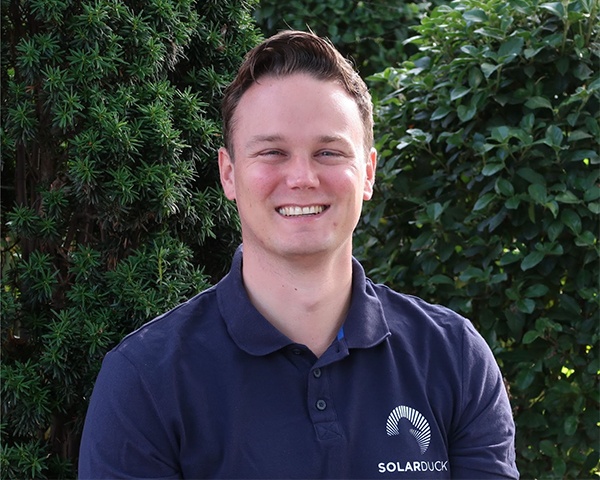


オラフ・デ・スワートは、再生可能エネルギースタートアップ企業SolarDuckの共同創業者で、日本のエネルギー問題解決のため、洋上太陽光発電の普及に熱心に取り組んでいます。その取り組みの一環として、彼は渋谷スタートアップビザを取得しました。

こんにちは、オラフ。最初に起業家になったきっかけは何ですか?
私は航空宇宙工学を学び、柔軟な太陽電池パネルの学位を取得しました。卒業後、10年間海運業界の研究開発チームで働いていましたが、私の情熱は常に太陽エネルギーにありました。
太陽光エネルギーと海運技術を組み合わせるというアイデアは、当時の同僚で現在は共同創業者となったメンバーとのブレインストーミングセッションから生まれました。私たちを結びつけたのは、太陽光エネルギーへの深い愛と、複雑な技術を世界中の人々が使えるシンプルなものに変換し、影響を与えるという情熱でした。私たちは本業の安全網の下で、夜や週末に作業を開始し、私は最初に企業を辞めた一人でした。
私は自分をリスクテイカーだとは思っていませんでしたが、この一歩を踏み出したことを嬉しく思っています。2020年夏、Katapult Ocean Acceleratorが当社のスタートアップに投資し、潜在的な市場への拡大戦略を後押ししました。
現在、当社はオランダ、ノルウェー、イギリスに拠点を置く8人のグローバルチームで構成されています。
それぞれが互いに補完し合うスキルセットを持ち、互いの能力に対して相互の尊重を抱いています。

当社のスタートアップについて、詳しくお聞かせいただけますか?
SolarDuckは、洋上での大規模な電力生産ソリューションを開発する再生可能エネルギースタートアップです。太陽光は未来最大のエネルギー源であり、既に最も安価な再生可能エネルギーオプションです。洋上太陽光発電を提供することで、視覚的な環境汚染を引き起こさず、希少な土地を犠牲にすることなく、豊富なエネルギー源を活用できます。
当社の社名は、太陽光発電の最大の課題を示す「ダックカーブ」グラフから由来しています。日中の時間帯に太陽光発電の出力が増加する一方、日没後は太陽光発電の出力は減少するにもかかわらず、電力需要は急激に増加します。当社のソリューションは、需要の高い地域(メガシティや高エネルギー消費型産業施設など)に直接電力を供給する能力を提供することで、太陽光発電の送電網への導入を妨げる要因を軽減し、より多くの太陽光発電を電力網に供給するのを支援することを目指しています。

なぜ日本市場を事業拡大の拠点として選択されたのでしょうか?
日本の国土の70%は山岳地帯で占められています。内陸部でのエネルギー発電所の建設は、土地の造成や貯水池の建設に多大な土木工事が必要のため、非常にコストがかかります。日本最大の太陽光発電所は100メガワット程度の発電量で、他の国と比べて非常に低い数値です。海上への進出により、これらの課題を大幅に軽減できるため、SolarDuckの製品にとって日本は最適な市場です。
今後数年間で、日本向けにコスト競争力のあるエネルギーソリューションの開発を計画しています。現地のパートナーと協力し、日本初の海上浮体式太陽光発電所の開発を既に進めています。コンセプトは、17×17メートルの浮体式プラットフォームに40枚の太陽光パネルを設置し、約16~20キロワットの電力を発電するものです。これらのプラットフォームは最大10メガワット規模のプラントに接続可能で、太陽光発電所として組み合わせれば容量は500メガワットを超える可能性があります。
なぜ渋谷スタートアップビザの申請を決意したのですか?
日本で会社を設立するには現地の拠点が必要です。事業設立には一定のコストがかかるため、製品が適切な市場かどうかを確認したいものです。スタートアップビザは、戦略的パートナーを探し、地方自治体を含む関係者と議論し、大規模なコストをかける前に堅固なパイプラインを確立する最良の方法です。
2020年12月に渋谷ウェルカムサービスに最初のメールを送信し、2021年5月に正式に応募しました。返信は非常に迅速で、全体の手続きは1ヶ月未満で完了しました。審査委員との面接後、1週間で合格通知を受けました。次の段階は在留資格認定証明書(CoE)の取得ですが、日本の緊急事態宣言のため、この書類の発行に少し時間がかかる可能性があります。
日本到着後の計画はどのようなものでしょうか?
既にプロジェクト開発を担当する日本のパートナー企業があります。最初のプロジェクトは最も複雑であり、材料のサプライヤー、設置プロセスにおけるパートナー、そしてもちろん投資家を探す必要があります。現地市場での実績が確立されれば、これらのパートナーが技術を最大限に拡大する支援をしてくれます。
オフショア浮体式太陽光発電が日本のエネルギー供給に大きな貢献をするかどうかを確認したいと考えています。そのためには関連する政府機関の協力が不可欠です。例えば、日本の経済産業省(METI)は再生可能エネルギーの開発において重要な役割を果たしています。SolarDuckは日本の現在の電力料金やフィードイン・タールフ(FIT)料金と直接競合する目標を掲げていますが、オフショア浮体式太陽光発電所の導入には一部制限がある可能性があります。METIと協力し、潜在的なボトルネックを特定し、解決策を策定したいと考えています。
現在、日本にはオフショア浮体式太陽光発電所を規制する技術認証制度は存在しません。グローバルにも同様の制度は未整備です。私たちは、この市場を長期的に発展させ、ギガワット規模への飛躍を可能にするための規制整備に貢献したいと考えています。
これらの課題を踏まえ、最初の数ヶ月間のスケジュールはかなり詰まっています。日本のネットゼロ移行を支援するこの挑戦に、意欲を持って取り組んでまいります。